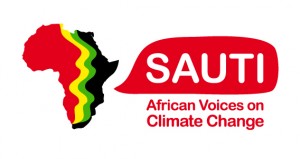In her first post for Sauti, leading climate organizer Winnie Asiti from  Kenya, eloquently expresses the impact climate change has had on her hometown and recounts the origins of her climate activism.
Kenya, eloquently expresses the impact climate change has had on her hometown and recounts the origins of her climate activism.
In my own words…
I was born and brought up in Trans Nzoia District, Kitale in the Rift Valley Province of Kenya. Renowned for being Kenya’s breadbasket for its ability to churn out tonnes upon tonnes of maize each year. I often watched in happiness as the maize bloomed and matured in the expansive fields. During such times all would be green; the maize fields, the grass, the trees and the forests, which invariably made up the undulating landscapes of this beautiful place.
All of that and more is gone now, the maize fields still shine upon the horizons of my hometown but it’s a different shade of green, as if it’s diluted. The grass lingers on, but no longer in abundance. The forests no longer stand tall, long cut down to satisfy the appetites of politicians and well-connected individuals or for some ‘development’ projects.
And with this the rivers are fast drying up in an area which serves as a major water catchment in the country. The huge fig trees no longer garland the sides of highways and paths in the villages; they were cut down and burned for charcoal, fuel wood and other commercial purposes. No one bothered to plant others so the land has been left bare.
Rain no longer comes when it should, maize would be planted in March, and now farmers have to see the rain before they attempt to plant anything due to its erratic nature. As a result the maize yields have tremendously gone down and it’s not uncommon to find whole fields filled with stunted maize crops whose only use is for cow feed.
In 2005, I joined university to study Environmental studies when everybody believed environment was equivalent to planting trees and wondered why anyone would take four years to study something like that. It is here that I joined and was voted in as a leader in the university environmental club (KUNEC). KUNEC was about creating awareness and putting into practice the theory that our lecturers churned day after day.
It is my involvement at this level that awakened me to the realities of environmental degradation and climate change helping me put linkages and add up happenings in my own hometown and make sense out of all that. Attending the UNFCCC COP 12 in Nairobi further heightened these concerns awakening me to the fact that for something to happen we all had to be part of it and it is here that the African Youth Initiative on Climate Change (AYICC) was formed. In 2007/2008, the InterVarsity Environment Network (IVEN) was born, a platform where university groups in Kenya could address environmental issues. It is within IVEN that an Environmental Education Programme for schools (EE) was initiated where campuses adopt schools in their vicinity and mentor them on various environmental and climate change issues. I visited schools around our university and started the program in these schools. It was slow at first but as time went by more and more volunteers joined the program to be part of a movement of enhancing young people’s sensibilities on climate change and other environmental issues.
I have since graduated from university and passed on the baton in the education program. I serve as a volunteer at the African Youth Initiative on Climate Change (AYICC). I have helped plan marches, plant trees, organize conferences, attended various forums, been to the COP and related meetings to try and make sense of the biggest crisis we face today. I have been part of the 350 movement since 2009 & have learnt the power of our voices, voices of communities, youth, women & other vulnerable groups and the belief that I am the change I long for! After the Copenhagen failure I wrote in a post on the AYICC Kenya blog that,
‘Looking back, the ‘disastrous’ Climate talks in Copenhagen may not be anything to write home about but one lesson much too well learnt must be that something has to be done, not through the complicated negotiations and conference rooms of the UNFCCC but through our own small actions. We can find solutions right here. In the long run this may well be the vehicle through which solid decisions are taken on climate change issues.’
This is my story…
Meanwhile, my hometown is no longer Kenya’s breadbasket and in most parts of my country Kenya, famine rages on, even in regions which previously produced enough to feed their own offspring and some! Climate change can no more be real than now…
For more information on the Sauti campaign, visit here.
